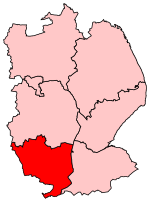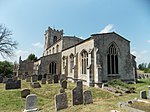South Kesteven
Local government districts of the East MidlandsNon-metropolitan districts of LincolnshireSouth Kesteven DistrictUse British English from December 2012

South Kesteven is a local government district in Lincolnshire, England, forming part of the traditional Kesteven division of the county. Its council is based in Grantham. The district also includes the towns of Bourne, Market Deeping and Stamford, along with numerous villages and surrounding rural areas. The neighbouring districts are North Kesteven, South Holland, Peterborough, North Northamptonshire, Rutland, Melton and Newark and Sherwood.
Excerpt from the Wikipedia article South Kesteven (License: CC BY-SA 3.0, Authors, Images).South Kesteven
Geographical coordinates (GPS) Address Nearby Places Show on map
Geographical coordinates (GPS)
| Latitude | Longitude |
|---|---|
| N 52.8 ° | E -0.5 ° |
Address
08902
New Jersey, Vereinigte Staaten von Amerika
Open on Google Maps











